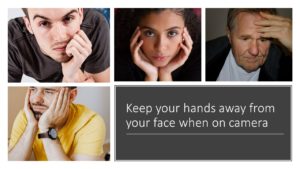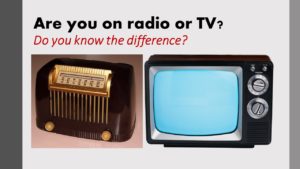How to Look better on virtual meetings: Think TV not Radio
How to Look better on virtual meetings: Think TV not Radio
Radio is only audio – words, voice, tone, pace pattern, music. The audio must be good.
TV is that plus the visual – body language, imagery, photos, movement. The audio must be good. The video must be better.
On TV the visual dominates the impact (if the audio quality is acceptable). Poor audio sabotages both radio and TV.
Let’s assume that your audio is acceptable. This standard can vary based on the circumstance and expectations.
If you still look and sound the same in 2021 as you did in April 2020 – it’s unacceptable. No more excuses. Upgrade your virtual meeting presence and presentation.
When you are in an online meeting or delivering a virtual presentation, you are on TV not radio. The success of your message is determined by how well you look and sound.
Nose
Your nostrils are not your most attractive feature so don’t showcase them. Instead, hide them. How do you do that? Position your camera at eye level, as if you are talking face to face with a person. When was the last time that you enjoyed looking up a person’s nose? We don’t want to look up your nose. If we can see the ceiling in your video that’s an indicator that we are not looking eye to eye with you. If we are examining the inside of your nostril the message is that you are looking down at us because you force us to look up at you.
Put your best face forward. Do you believe that’s your nostrils?
Headphones
If you are interviewed in a radio studio, they might give you headphones to wear because it doesn’t mater what you look like. The host might wear headphones so they can hear the audio that is broadcast. They might even receive private messages from the producer during the show.
Have you ever seen a TV newscaster or talk show host wearing headphones? No. Because that would look silly. Headphones are for radio not TV. Headphones on virtual presentations look goofy and amateur.
There might be times that you are in a Zoom meeting from a noisy location – your factory, open office or kitchen. Then you might need to wear headphones. These are exceptions to the goofy headphones rule.
Eye Contact
On radio there is no eye contact. On TV there is only imagined eye contact. When you are on TV, you must imagine the viewer behind the camera and talk to that person through the camera. If you are interviewed on a TV station, there is no studio audience. You simply look at the camera and imagine the listener.
When you are speaking in a virtual presentation you might be tempted to look at the images on the screen. Don’t do that because when you do that you aren’t making eye contact with the viewer. You’re simply satisfying your need to see people. That means you are more focused on you, not your audience. You might argue that when you are in the same room you make eye contact and see them at the same time. Agreed. In a virtual you aren’t in the same room, so you compromise and act in the best interest of the view from your audience.
It’s more important that they believe you are looking at them.
Face
Perhaps you’ve heard the expression, “a face for radio”. You might have thought that meant an ugly face. Maybe. Perhaps it also refers to a face that is unexpressive, ungroomed and scary.
In a virtual meeting your face is the key source of body language. You can use it to smile if you want to appear friendly. You might nod to demonstrate agreement, tilt your head to indicate interest, frown to indicate discomfort, furrow your brows to show concern or confusion…
Your face can help you visually convey many messages if only you allow it.
Who wants to stare at a “face for radio”?
Dress
It’s easy to dress for radio. Wear whatever you want, and the audience doesn’t know or care. How many of those early morning radio personalities are wearing pyjamas and house coats? On TV you need to dress up – at least for the upper part of your body that appears on camera. Dress the part.
If it’s a business meeting, dress for a business meeting. It doesn’t need to be business formal – at least business casual.
Hands
On radio, we can’t see your hands, yet using your hands helps you express yourself with more energy in your voice. Voice actors use their hands to help them sound more expressive on the microphone.
On TV, your hands can aid your expression both audibly and visually. The most important rule about your hands when on TV – is to keep them away from your face.
Avoid caressing your cheek, rubbing your chin or scratching your nose. These are distracting from your message and suggest discomfort at best or deceit at worst.
As in any presentation, the key consideration is “What does your audience see, hear, feel and think?”
It’s not about what you see, hear, feel and think.
You present for the benefit of the audience not your gratification.
When you are delivering a virtual presentation or leading a virtual meeting – you are on TV, not radio. Demonstrate that you know the difference.
Read more on Virtual Presentations
Why do Zoom Presentations Suck and What to do about that?
Why Use Zoom Chat in your virtual presentations and meetings?




